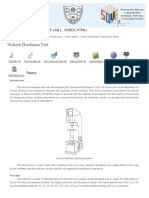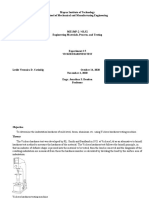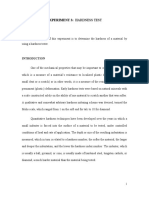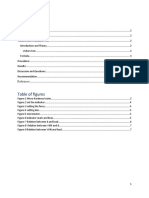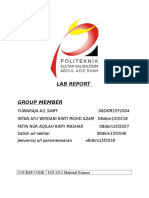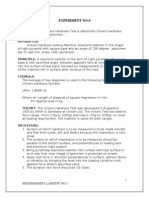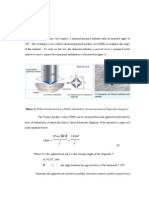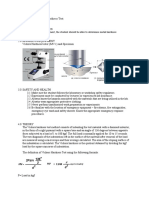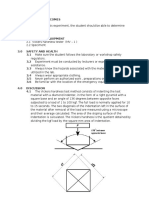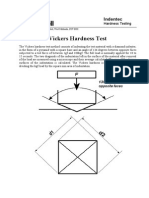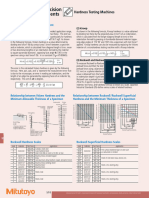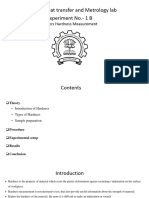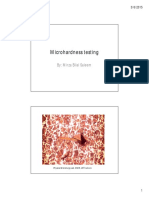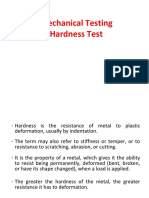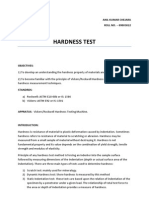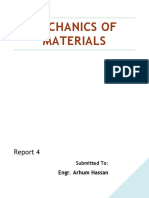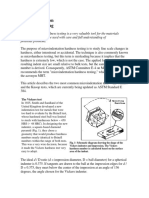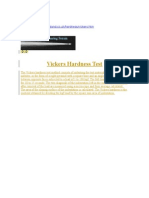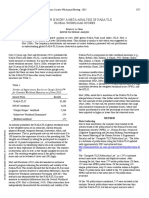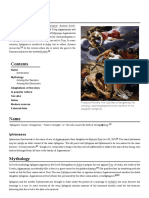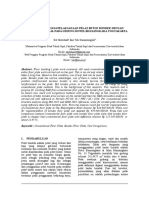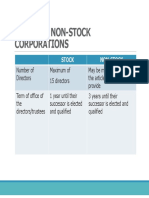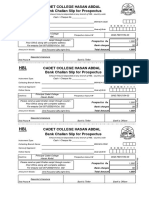POLITEKNIK SULTAN SALAHUDDIN ABDUL AZIZ SHAH
Mechanical Engineering Department
LAB SHEET
Programme Diploma in Mechanical Engineering
Course Code DJJ30113-Material Science & Engineering
Title Vickers Hardness
Lab. No. DJJ30113/DKM/LS/3.3 ( 01 )
LEARNING OUTCOME (CLO):
Upon completion of this laboratory, students should be able to:
CLO2: Performed appropriate material testing according to the Standard Operating
Procedures. (P4, PLO5)
CLO3: Demonstrate the ability to work individually and in groups to complete assigned tasks
during the practical work session. (A3, PLO9)
ACTION NAME & DESIGNATION SIGNATURE DATE
Prepared by:
Checked by:
Approved by:
BIL. GROUP MEMBERS MATRIC NUMBER
1. MUHAMMAD AZIM BIN OSMAN 08DKM20F2006
2. AIDIL HAKIMI BIN CHE NASARUDDIN 08DKM20F2038
3. MUHAMMAD DANIE BIN AMIR SAIFUDDIN 08DKM20F2011
4. MUHAMMAD ZAFRI HAIQAL BIN FAUZI 08DKM20F2031
1
�Theory
Introduction
The Vickers hardness test was developed by RL. Smith and Sandland in 1921 at
Vickers Ltd as an alternative to brinell hardness test method to measure the hardness of the
material. The Vickers hardness test follows the brinell principle, in that an indenter of definite
shape is pressed into the material to be tested, then the load is removed and the diagonals of
the resulting indentation are measured from these the hardness number is calculated by
dividing the load by the surface area of indentation.
Vickers hardness testing machine
The Vickers test is easier than other hardness tests since the required calculations are
independent of the size of the indenter and the indenter can be used for all materials
irrespective of hardness.
Principle
The indenter is made of diamond and is in the form of a square-based pyramid with
an angle of 1360 between faces. The faces of diamond indenter are highly polished, and the
point is sharp. The loads applied vary from 1 to 120 kg; the standard loads are 5, 10, 20, 30,
50, 100, and 120 kg. For most hardness testing, 50 kg is maximum.
The Vickers test can be used for all metals and is one of the widely used test among
hardness tests. The unit of hardness is known as the VICKERS PYRAMID NUMBER (HV) or
2
�DIAMOND PYRAMID HARDNESS (DPH). The hardness number can be calculated by the
load over the surface area of the indentation.
Implementation
The angle between the two faces of diamond indenter used in Vickers hardness test
is 136 and the faces makes an angle 22 o with the horizontal. The HV number is then
o
determined by the ratio F/A, where F is the force applied to the diamond in kilograms-force
and A is the surface area of the indentation in square millimeters. A can be determined by the
formula.
A=d2/2sin(136°/2)ʹ
by eliminating the sine term we get,
A=d2/1.8544ʹ
Where d is the average length of the diagonal in millimeters. Hence,
HV=F/A=(1.8544F/d2)kgf/mm2
Where F is in kgf and d is in millimeters.
The corresponding units of HV are then kilograms-force per square millimeter
(kgf/mm). To calculate Vickers hardness number using SI units we must convert the force
applied from kilogram-force to Newtons by multiplying by 9.80665 (standard gravity) and then
3
�dividing by 1000 to get the answer in GPa. This will leads to the following equation that can
be used to do any calculation directly.
HV=0.1891(F/d2)GPa
Where F is in N and d is in millimeters.
Vickers hardness numbers are expressed as xxxHVyy, e.g.440HV30, or xxxHVyy/zz
if duration of force differs from 10 s to 15 s, e.g.440HV30/20,Where:
440 is the hardness number,
HV gives the hardness scale (Vickers),
30 is the load used in kgf.
20 is loading time if it differs from 10s to 15s
Vickers values are not dependent of the test force: they will be same for 500gf and
50kgf, as long as the force is at least 200 gf.
For thin samples indentation depth can be an issue due to substrate effects. In other
waysindent depth can be calculated according to:
h=d/2√2 tan(136°/2 )=d/7.0006ʹ
Examples of HV values for various materials
Test specimen
The test should be carried out on a surface which is smooth, even, free from oxide,
foreign matter and lubricants.The thickness of the test piece or of the layer under test shall be
at least 1.5 times the diagonal length of the indentation.For test piece of small cross section
or of irregular shape, it may be necessary to provide some form of additional support.
Precautions:
When doing the hardness tests the distance between indentations and the distance
from the indentation to the edge of the specimen must be taken into account. These minimum
distances are different for ISO 6507-1 and ASTM E384 standards.
4
�Relevant Indian standard for Vickers hardness
IS 1501:2002, method for Vickers hardness test for metallic materials.
5
�6
�7
�8
�9
�Result
Trial Specimen Load Average Vickers Average
Applied Diagonal Hardness Vickers
(Kg) Length Number Hardness
(mm) Hv=0.8191F/d2 Number
1 ALUMINIUM 10 0.362 141.48 139.56
2 0.367 137.65
1 BRASS 20 0.463 172.97 180.11
2 0.445 187.25
Discussion
1.Which principle does Vickers hardness test follows?
• The Vickers hardness test is based on the Brinell principle: a definite-shaped
indenter is pressed into the material to be tested, the load is removed, the
diagonals of the resulting indentation are measured, and the hardness
number is calculated by dividing the load by the indentation's surface area.
2.How Vickers hardness test is different from other hardness tests?
• The Vickers hardness test is frequently viewed as being more user-friendly
than other hardness tests: The procedure can be carried out using a universal
or micro hardness tester; the calculations necessary are independent of the
indenter size; and the same indenter (a pyramidal diamond) can be used for
all materials, regardless of hardness
Coclusion
• The Vickers Hardness Test is simple to use, and the advantages significantly
exceed the drawbacks. Because of its adaptability, it may be used to
determine the hardness of practically any material. The test is a potential
addition to any testing facility or workshop because of its broad range of
applications and ease of maintenance for its testers.
Reference
• “Vickers Hardness Test Report - 912 Words | Internet Public Library.” Vickers Hardness Test
Report - 912 Words | Internet Public Library, www.ipl.org, https://www.ipl.org/essay/Vickers-
Hardness-Test-Report-FKV57C3RJ4D6. Accessed 29 May 2022
• “Virtual Labs.” Virtual Labs, sm-nitk.vlabs.ac.in, https://sm-nitk.vlabs.ac.in/exp/vickers-
hardness-test/simulation.html. Accessed 29 May 2022
• “Vickers Hardness Testing Insight | Struers.Com.” Vickers Hardness Testing Insight |
Struers.Com, www.struers.com, https://www.struers.com/en/Knowledge/Hardness-
testing/Vickers#about
• “Vickers Hardness Testing.” Vickers Hardness Testing, www.hardnesstesters.com,
https://www.hardnesstesters.com/test-types/vickers-hardness-testing. Accessed 29 May 2022
10
